Join us for conversations that inspire, recognize, and encourage innovation and best practices in the education profession.
Available on Apple Podcasts, Spotify, Google Podcasts, and more.
Look for the following topics in the video, indicated by the ![]() onscreen icon, and click below to learn more.
onscreen icon, and click below to learn more.
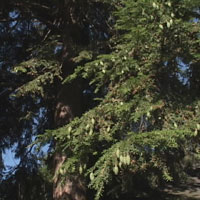 What is an Ecosystem? |
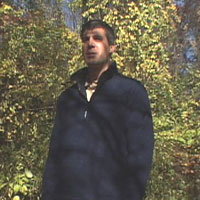 Matter and Life |
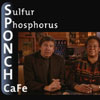 The SPONCH CaFe |
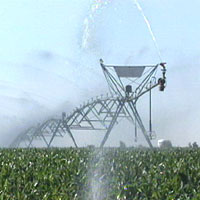 Building Bodies |
|
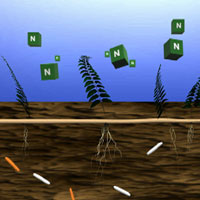 Material Cycles |
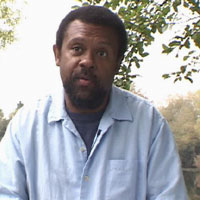 Scientist at Work |
Curriculum Resources |
||
An ecosystem is defined as a self-sustaining community of organisms living in a physical environment. Part of what sustains an ecosystem is the constant interchange of matter between its living and physical components. This is the focus of Session 8: Material Cycles in Ecosystems.

Coniferous forest, a North American ecosystem
Ecosystems can be vast, like the tropical rainforests that occur along the equator. They can also be very small, like the ecosystem inside the leaves of pitcher plants discussed by Dr. Aaron Ellison in the video.
An ecosystem is shaped by physical factors such as rainfall, temperature, humidity, sunlight, and soil type. The interaction of these factors determines the types of organisms that live there. Scientists classify larger terrestrial ecosystems into several major types that occur over wide geographical areas. They are recognized by their distinctive climates and are given their names from the dominant plant life.
The ecosystems listed below are found in North America, including Hawaii. Which ecosystem do you live in?
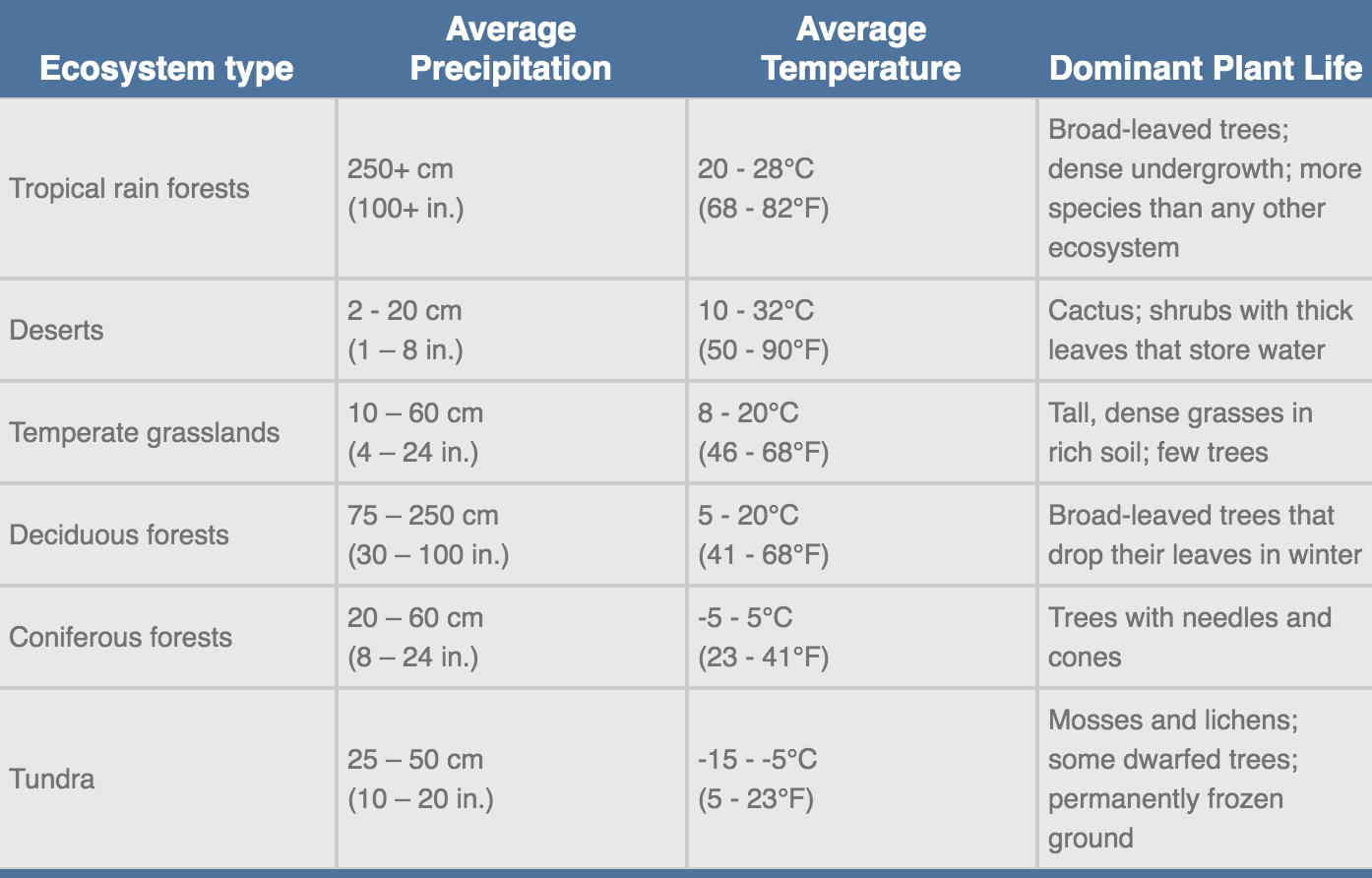

Dr. Adrian Finzi in the
deciduous forest
All things — living and nonliving — are made of matter, and all matter is composed of tiny particles called atoms. Atoms combine together to form molecules. Atoms of different types are called elements. In the video for Session 8, Dr. Adrien Finzi walks us through a deciduous forest ecosystem and identifies some of the elements that compose living — or organic — matter. These elements include carbon (C), hydrogen (H), nitrogen (N), oxygen (O), phosphorus (P), sulfur (S), calcium (Ca) and iron (Fe). Nonliving — or inorganic — matter contains these elements too, but in very different proportions.
One of the five characteristics used to define life in Session 1 (What is Life?) was the need for a constant supply of matter. Why is this? In any organism, matter is constantly being used to both build and sustain the organism. Cell parts are continuously being replaced. In the thousands of chemical processes that go on inside a cell, atoms and molecules are both input and output. On a molecular level, almost all the matter that composes an organism at some point becomes part of the waste products that are expelled into the external environment. This matter must continuously be replaced.
Matter can exist in different states: Scientists classify matter into four states: solid, liquid, gas, and plasma. Life is composed of, and interacts with, matter in the first three states — we are made of matter in solid, liquid, and gaseous forms. Plasma is a state of matter that composes the bulk of the universe. On Earth, plasma exists naturally only as lightning and the Aurora Borealis.
Matter can change states: We are all familiar with the molecule H2O in its three states: solid (ice), liquid (water), and gas (vapor). Water and other molecules can change states, usually as a result of changes in temperature or pressure. As part of life’s chemical reactions, atoms can be moved around to molecules in different states. In photosynthesis, for example, the carbon in carbon dioxide gas and the hydrogen in liquid water become part of a sugar molecule, which is a solid.
The basic units of matter cannot change forms: You may recall from Session 7 (Energy Flow in Communities) that energy can change forms. With a few exceptions that occur in extreme conditions, the basic units of matter — atoms — cannot change forms. As far as life is concerned, a carbon atom will remain a carbon atom no matter how it moves around from molecule to molecule. Your carbon atoms may have once been part of the first life form on Earth or even a Tyrannosaurus rex.
Matter is conserved: A property that matter shares with energy is that it is conserved. What this means is that the total amount of matter that is part of a system stays the same, even if the matter changes state or the atoms and molecules are rearranged in chemical reactions many times. This translates to the level of atoms. If you start with a certain number of carbon atoms, for example, you’ll end with that same number even though they may be in different molecules.
Matter stores energy: Atoms and molecules represent stored energy. The type of energy most important to sustaining life is the chemical energy stored in food. Matter and energy travel together in food along food chains. While the amount of useful energy decreases as energy changes form at each link in a food chain (i.e., it becomes heat energy), matter does not change form and ultimately remains available to the living world.
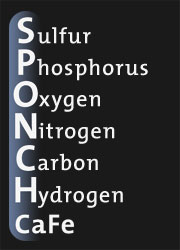
The elements represented by
the SPONCH CaFe
In the video for Session 1, our host Dr. Doug Zook offered a simple mnemonic to remember the key elements that compose living things: the SPONCH CaFe. The letters are symbols for chemical elements: carbon (C), hydrogen (H), nitrogen (N), oxygen (O), phosphorus (P), sulfur (S), calcium (Ca) and iron (Fe). Although the symbols are not in order of relative abundance (that would be OCHNCaPSFe — hardly simple to say!), together these elements compose 99.8% of all living things.
You may recall from Session 1 that the molecules that compose living things are called organic molecules. Organic molecules are built from repeated subunits that are built from the elements in the SPONCH CaFe. Let’s take a look at some representative subunits to see where these elements are found.
| Organic molecule | Subunit | Elements | Example |
|---|---|---|---|
| Carbohydrate | Sugar | C,H,O | 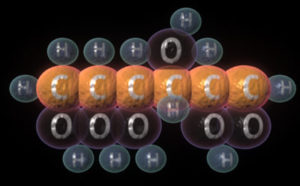
Glucose |
| Protein | Amino acid | C, H, O, N
(S in some) |
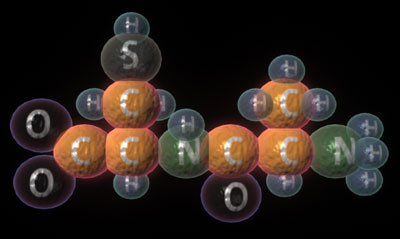
Two linked amino acids: |
| Lipid | Fatty acid | C, H, O
(P and N in some) |
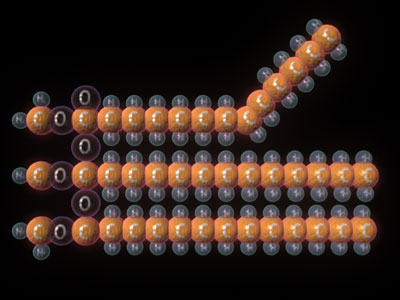
Glycerol linked to three fatty acid chains |
| Nucleic acid | Nucleotide | C, H, O, P, N | 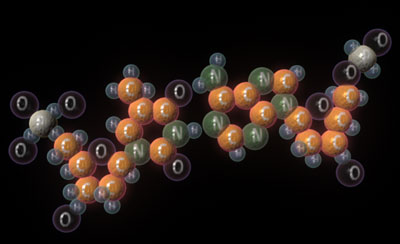
Two linked nucleotides: |
Carbohydrates store energy. The starch in a potato is a good example. They also act as structural components, such as the cellulose that makes a celery stalk stringy or the chitin that composes the outer skeleton of a beetle.
Proteins are what the cell uses to translate the information in DNA into cell products. Proteins act as enzymes, which are important in making chemical reactions happen in cells. There are also structural proteins. Hair and cartilage are good examples.
Lipids perform a variety of functions. Fats store energy. Cell membranes are made of a type of structural lipid. Sex hormones, such as testosterone and estrogen, are made of lipids. The pigment chlorophyll, which is important in photosynthesis, is a lipid.
Nucleic acids include DNA, which carries genetic information, and RNA, which translates that information into proteins.
The other elements in the SPONCH CaFe are calcium (Ca) and iron (Fe). Calcium is an important structural component. Bones and teeth contain calcium. It’s also critical in keeping body chemistry in balance. Iron is important in the synthesis of hemoglobin, which is responsible for carrying oxygen in blood.

In this forest, producers take in
water and carbon dioxide
Building a living body requires a constant supply of matter from external sources. Once that matter is taken in, it must be processed so that it can be used by the organism. Stated simply, as matter is processed, molecules are broken down and their atoms are rearranged to form different molecules. These new molecules, alone or combined, serve to build and sustain the organism that synthesized them.
There are a few notable differences in how bodies are built in producers, consumers, and decomposers.
Producers represent the bridge for matter from the nonliving to the living world. Plants are a good example. Plants take in carbon dioxide gas from the air and water from the soil. From these inorganic molecules, they synthesize the organic molecule sugar and release oxygen gas as a by-product. Sugar plays two roles. Sugar is the food that supplies energy to the plant. It is also the raw material from which all the other organic molecules that compose a plant are built. The other elements that are required to sustain a plant’s life, such as nitrogen and phosphorus, are obtained from the soil.
Consumers obtain matter to build their bodies from food. All of the classes of organic molecules are found intact in a consumer’s food. Ingestion brings this matter in and digestion breaks it down into the molecular subunits described earlier (i.e., sugars, amino acids, fatty acids). These subunits are then absorbed into cells, where cell processes rebuild them into the organic molecules that compose the consumer. Vitamins and minerals are also a part of a consumer’s food. Vitamins are organic molecules formed by living things. Minerals are inorganic and originate from the physical environment. Both are critical to life processes.
Decomposers also build their bodies from food. They are considered to be a special class of consumers that are distinguished from others because their food consists of dead bodies as well as the solid and liquid wastes from consumers. As part of building their bodies, the decomposers release inorganic molecules as waste products. In this way, decomposers return matter in the living world to the nonliving world. While considered wastes for the decomposers, however, this matter is what plants take in as nutrients. Decomposers thus represent a critical link in material cycles.
Sometimes called nutrient cycles, material cycles describe the flow of matter from the nonliving to the living world and back again. As this happens, matter can be stored, transformed into different molecules, transferred from organism to organism, and returned to its initial configuration. The implications of material cycles are profound. There is essentially a finite amount of matter on Earth (with some input from meteors and other astronomical objects). Life uses certain types of matter (the SPONCH CaFe) by removing and concentrating it in living bodies. What would happen if this matter weren’t recycled? Fortunately, material cycles avert this situation.
The carbon cycle The first material cycle described in the video is the carbon cycle, which is also a cycle for oxygen. The carbon cycle involves two chemical reactions that are also important in energy flow: photosynthesis and cell respiration. Both of these reactions are described in detail in “A Closer Look” for Session 7. If you compare the two reactions, you can see that one is the reverse of the other in terms of matter. Carbon enters the living world as carbon dioxide gas, which is “fixed” (made useful to life) into sugar molecules. Carbon is recycled to the nonliving world as carbon dioxide gas; oxygen is recycled as oxygen gas. Oxygen from oxygen gas is never “fixed” in the way carbon is. It is used to “burn” sugar for energy.
Photosynthesis:
light energy + CO2 + H2O -> CH2O + O 2
light energy + carbon dioxide + water -> sugar + oxygen
Cell Respiration:
CH2O + O2 -> CO2 + H2O + energy
sugar + oxygen -> carbon dioxide + water + energy
 The nitrogen cycle The second material cycle, described by Dr. Nicky Sheats in the video, is the nitrogen cycle. The main reservoir of nitrogen in the nonliving world is the atmosphere, where it exists as nitrogen gas. Plants, animals, and most other life forms cannot use nitrogen gas. Certain bacteria, however, use nitrogen gas as a nutrient. In a series of steps involving bacteria, nitrogen is fixed into a form that can be used by plants and other producers. Like carbon, nitrogen may travel through the links of a food chain in food. Ultimately, however, nitrogen resides in the wastes of consumers and the dead bodies of all life forms. Another group of bacteria uses this matter for food, and in doing so, releases nitrogen gas as a by-product.
The nitrogen cycle The second material cycle, described by Dr. Nicky Sheats in the video, is the nitrogen cycle. The main reservoir of nitrogen in the nonliving world is the atmosphere, where it exists as nitrogen gas. Plants, animals, and most other life forms cannot use nitrogen gas. Certain bacteria, however, use nitrogen gas as a nutrient. In a series of steps involving bacteria, nitrogen is fixed into a form that can be used by plants and other producers. Like carbon, nitrogen may travel through the links of a food chain in food. Ultimately, however, nitrogen resides in the wastes of consumers and the dead bodies of all life forms. Another group of bacteria uses this matter for food, and in doing so, releases nitrogen gas as a by-product.
All of the elements in the SPONCH CaFe are recycled, although some take longer than others. A generalized material cycle can be described for most of these elements. Most elements have a reservoir in bedrock. As bedrock decays, these elements, in various molecules, enter the soil. As soil nutrients, these molecules are taken into plants, where they are processed to become part of a plant’s body. From there, these nutrients may travel along food chains, but ultimately become solid or liquid wastes or dead bodies. In using this matter for food, the decomposers return these nutrients back to the soil.
 Dr. Nicky Sheats received his Ph.D. in the Department of Earth and Planetary Sciences at Harvard University in 2000, where his field of study was biological oceanography with a focus in stable isotope biogeochemistry. His doctoral dissertation focused on determining if sewage nitrogen was being incorporated into the food webs of the Delaware River Estuary and Massachusetts Bay. Currently Dr. Sheats is researching urban air pollution as a post-doctoral fellow at the Earth Institute at Columbia University.
Dr. Nicky Sheats received his Ph.D. in the Department of Earth and Planetary Sciences at Harvard University in 2000, where his field of study was biological oceanography with a focus in stable isotope biogeochemistry. His doctoral dissertation focused on determining if sewage nitrogen was being incorporated into the food webs of the Delaware River Estuary and Massachusetts Bay. Currently Dr. Sheats is researching urban air pollution as a post-doctoral fellow at the Earth Institute at Columbia University.
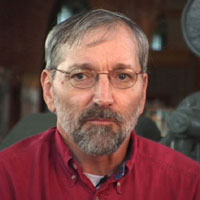 In 1989, Dr. Charles Tyler started work at the Professional Services Group, Inc. as an operations specialist on the Boston Harbor Project (BHP), where he contributed to operational planning and operational review and input to the conceptual and detailed design of the 1.27 billion-gallon-per-day wastewater facility on Deer Island. After working for over five years with the construction management firm on the BHP, Tyler “jumped the fence” and joined the Massachusetts Water Resources Authority as a project manager in the process group, a group of specialists who focused on punchlisting and construction turnover, and the start-up of the newly-constructed facilities on Deer Island. Tyler, who began his career in wastewater operations in 1977, now works on operations and maintenance with technical and process issues in Deer Island ’s effort to keep the huge facility operating optimally.
In 1989, Dr. Charles Tyler started work at the Professional Services Group, Inc. as an operations specialist on the Boston Harbor Project (BHP), where he contributed to operational planning and operational review and input to the conceptual and detailed design of the 1.27 billion-gallon-per-day wastewater facility on Deer Island. After working for over five years with the construction management firm on the BHP, Tyler “jumped the fence” and joined the Massachusetts Water Resources Authority as a project manager in the process group, a group of specialists who focused on punchlisting and construction turnover, and the start-up of the newly-constructed facilities on Deer Island. Tyler, who began his career in wastewater operations in 1977, now works on operations and maintenance with technical and process issues in Deer Island ’s effort to keep the huge facility operating optimally.
The Understandings of Consequence Project, part of Project Zero at the Harvard Graduate School of Education, aims to help students learn difficult science concepts by engaging them in how scientists think about the underlying causality.
Students have limited knowledge of the nature of causality so they often distort information that they are learning to fit with a simpler causal model. With funding from the National Science Foundation, the project has developed a series of curriculum modules that present ways of thinking about cause and effect that students need to master in order to develop deep understandings of scientific concepts. Each unit identifies the difficulties that students tend to have in that topic and offers activities to address the difficulties. For more information, contact:
Dr. Tina A. Grotzer
Understandings of Consequence Project
Project Zero, Harvard Graduate School of Education
http://www.pz.harvard.edu/
Note: The Understandings of Consequence Project was developed with funding from the National Science Foundation (Grant No. REC-9725502 and REC-0106988). All opinions, findings, conclusions or recommendations expressed therein are those of the authors and do not necessarily reflect the views of the National Science Foundation.